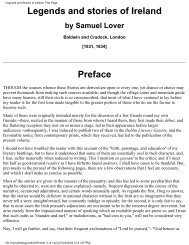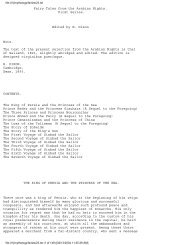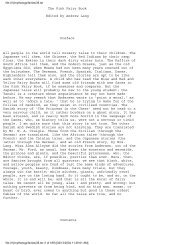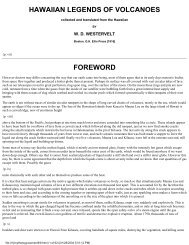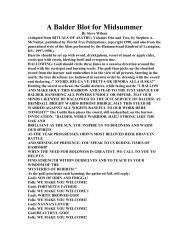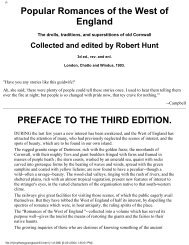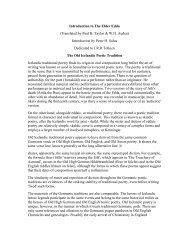Irish Druids And Old Irish Religions PREFACE CONTENTS
Irish Druids And Old Irish Religions PREFACE CONTENTS
Irish Druids And Old Irish Religions PREFACE CONTENTS
You also want an ePaper? Increase the reach of your titles
YUMPU automatically turns print PDFs into web optimized ePapers that Google loves.
Patrick--"The prayer which it contains against women, smiths, and <strong>Druids</strong>, together with the invocation of the powers of the sky, the sun,<br />
fire, lightning, &c., proves that, notwithstanding the undoubted piety and fervent Christian faith of the author, he had not yet fully shaken<br />
off the pagan prejudices." Giraldus Cambrensis declared that the <strong>Irish</strong>, at the conquest by Henry II., justified their condemnation by the<br />
Pope," being more ignorant than all other nations of the first principles of the faith."<br />
The legends of the English and French might be shown to contain a vast amount of questionable common sense and faith; but our present<br />
inquiry is to trace the underlying opinions of the ancient <strong>Irish</strong>.<br />
Leaving outside the so-called Druidical megalithic monuments, about the origin of which, in circles, pillars, &c., we know little or nothing<br />
beyond speculation, and which are scattered almost all over the globe, we notice in the <strong>Irish</strong> certain notions and practices connected with<br />
stones that reflect the manners of former times.<br />
The stone of Cuamchoill, near Tipperary, produced blindness on those who gazed on it. Stones of Speculation, Liath Meisieth, used to<br />
draw fire, were much revered. One object in the <strong>Irish</strong> Museum, of brass cased in silver, six inches by four, has the precious crystal in the<br />
centre, set round with coloured stones. The footprints of the angel Victor were to be seen on a stone in Down County, as the celestial being<br />
alighted to deliver-his message from on high to St. Patrick.<br />
In the Glimpses of Erin, by S. and Alice Milligan, an interesting notice occurs of the Brash or Bullan stones, in Cork Co, though there is a<br />
specimen at the Seven<br />
p. 81<br />
Churches of Glendalough. "The upper surface of this monument," say they, "is indented with four deep basin-shaped hollows. Two of<br />
them, the smallest, are quite close to each other at one edge; the other two, of larger size, are at the opposite edge. The devotee placed his<br />
or her knees in the smaller hollows; and, repeating a certain number of prayers, dropped an offering of some minute article into the larger.<br />
This operation, with certain rounds and washings at the Well, was deemed a specific for rheumatic pains and other ailments."<br />
It is added, of the Brash superstition, "This is a pagan cultus, which all the power of Christianity, the personal influence of the cleric, and<br />
national education, have not been able to obliterate." A respectable farmer declared that he was not above saying a prayer at the "blessed<br />
stone" when he came that way. The water found in hollows of Bullan stones was held good for bad eyes.<br />
Upright Standing Stones, or Dallans, the same authorities assure us, are reverenced as in idolatrous India. Mr. Milligan says, "The<br />
Inismurray women kneel before these stones, and pray that they may be delivered from the perils of childbirth." St. Bridget's stone at the<br />
Faughard, Louth, has a raised work round it, with St. Bridget's pillar near it upon steps, round which the devotees walk.<br />
The Clocha breca, or speckled stones of Inismurray, Sligo, are thus described by Dr. O'Donovan--<br />
"They are round stones, of various sizes, and arranged in such order that they cannot be easily reckoned; and, if you believe the natives,<br />
they cannot be reckoned at all. These stones are turned, and, if I understand them rightly, their order changed by the inhabitants on certain<br />
occasions, when they visit the shrine to wish good or evil against their neighbours." An aeir, or long-curse, has been often thus hurled<br />
against a private enemy.<br />
p. 82<br />
There is no account of the people, as recorded of some Celts, worshipping a bloody spear, or one placed in a vase upon the altar, as With<br />
the Scythians; but Spenser, in Queen Elizabeth's time, observed the <strong>Irish</strong> drink blood in a certain ceremony, and swear by the right hand of<br />
their chiefs.<br />
Solinus, in the early Christian centuries, must have heard strange tales of Eric, when he left this record--"It is a surly, savage race. 'the<br />
soldier in the moment of victory takes a draught of his enemy's blood, and smears his face with the gore. The mother puts her boy's first<br />
food, for luck, on the end of her husband's sword, and lightly pushes it into the infant's mouth, with a prayer to the gods of her tribe that<br />
her son may have a soldier's death."<br />
The Evil Eye was an object of dread, and penalties concerning it are conspicuous in the old Brehon laws. The Suil Bhaloirs, or Balor eye,<br />
relates to one Balor, who was able by an eye to strike a foe dead. Love potions, on the contrary, are referred to in many ancient songs.<br />
Persons were put under vows to do or not to do a thing. They were said to be under Gesa. This was often imposed with certain spells or<br />
charms.<br />
Raising the wind--so valuable a power in sailing days--was the privilege of a few, and had its votaries down to the last century.<br />
Windbound fishermen of the Hebrides, too, used to walk, sunwise, round the chapel of Fladda, in Fladdahuan Isle, and pour water upon a<br />
round, bluish-looking stone. This effectually raised a wind. The gods then kept the wind in bags. Not so long ago, old women in the<br />
Shetlands would sell wind to sailors.<br />
Dreams have played a great part in Ireland. In St. Patrick's Confession they are referred to. Professor O'Curry explains the meaning<br />
attached to them by the peasantry. Auguries were taken from the flight of birds, from beasts,<br />
p. 83<br />
file:///I|/mythology/witchcraft/8/8.html (30 of 114) [02/05/2004 8:38:14 AM]



